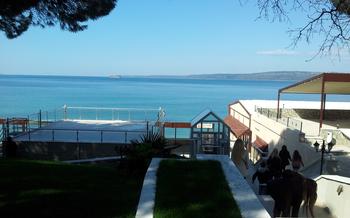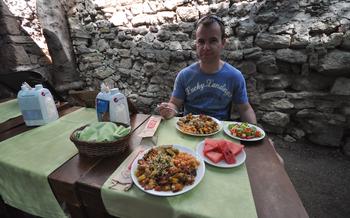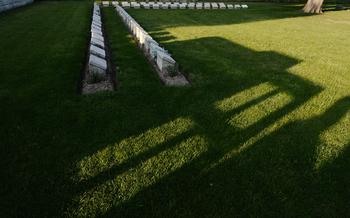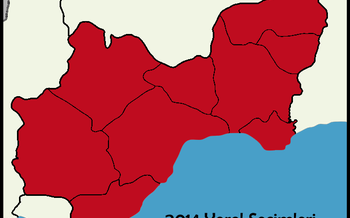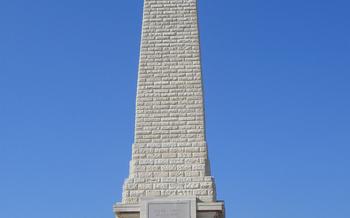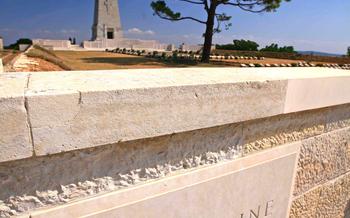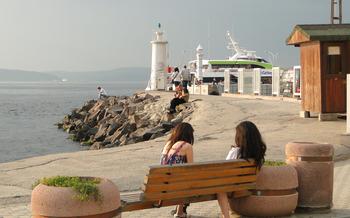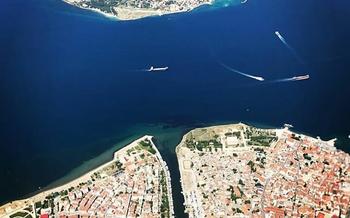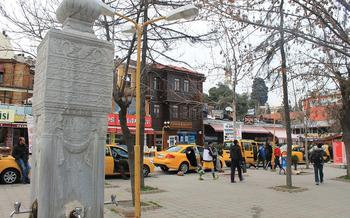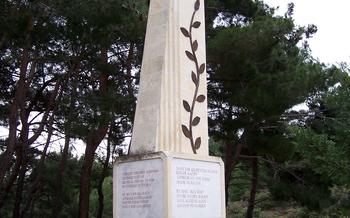
Gallipoli Peninsula War Exhibits
- The Gallipoli Peninsula: A Historical Overview
- Visiting the Gallipoli Peninsula War Exhibits: A Guide
- The Lone Pine Australian Memorial: A Tribute to Courage and Sacrifice
- The Turkish 57th Regiment Memorial
- Chunuk Bair New Zealand Memorial
- The Nek Cemetery
- The Anzac Cove
- The Kemal Atatürk Monument: A Tribute to a Great Leader
- The Gallipoli Museum
- The Kabatepe War Museum
- The Çanakkale Martyrs' Memorial: Honoring the Fallen
- The Gallipoli Historical National Park
- The Gallipoli Film Festival
- Insider Tip: Respect and Remembrance
The Gallipoli Peninsula: A Historical Overview
The Gallipoli Peninsula, a narrow strip of land jutting out into the Aegean Sea, holds a profound historical significance, particularly in the context of World War I. During the war, the peninsula became a battleground, hosting one of the most significant campaigns—the Gallipoli Campaign. This campaign, launched by the Allied forces in 1915, aimed to capture the Ottoman capital, Constantinople (present-day Istanbul), and secure a sea route to Russia. The campaign, however, faced fierce resistance from the Turkish forces under the command of Mustafa Kemal Ataturk, resulting in a stalemate and heavy casualties on both sides. The Gallipoli Campaign ultimately ended in a defeat for the Allied forces, leaving a lasting impact on the course of the war and the history of the region.
Visiting the Gallipoli Peninsula War Exhibits: A Guide
Visiting the Gallipoli Peninsula War Exhibits is an enriching experience that takes you back in time to one of the most significant battles in history. Here are some essential tips to help you plan a successful trip:
-
Plan Your Visit: The peninsula is vast, with numerous sites to explore. Allocate enough time to visit the key sites that align with your interests. Check the operating hours and any seasonal closures before your visit.
-
Key Exhibits and Memorials: Must-see exhibits include the Lone Pine Australian Memorial, the Turkish 57th Regiment Memorial, the Chunuk Bair New Zealand Memorial, and the Nek Cemetery. Each site offers a unique perspective on the battle and commemorates the fallen soldiers.
-
Guided Tours: Consider joining a guided tour to gain insights from expert historians. Guided tours often provide transportation, allowing you to focus on the historical narratives without worrying about logistics.
-
Self-Guided Exploration: For a more personal experience, opt for self-guided exploration. Maps and guides are available at the visitor centers to help you navigate the sites.
-
Respectful Behavior: Remember that this is a place of remembrance and respect. Observe silence at memorials and cemeteries, dress appropriately, and refrain from any disrespectful behavior.
The Lone Pine Australian Memorial: A Tribute to Courage and Sacrifice
Amidst the tranquil surroundings of the Gallipoli Peninsula, the Lone Pine Australian Memorial stands as a poignant tribute to the valiant soldiers who fought in the Battle of Lone Pine. This pivotal engagement, which took place in August 1915, witnessed intense hand-to-hand combat between Australian and Turkish forces, resulting in heavy casualties on both sides. The memorial, inaugurated in 1934, immortalizes the memory of the fallen and serves as a reminder of the profound sacrifices made during the Gallipoli Campaign.
The Lone Pine Memorial is a simple yet evocative structure, designed by Australian architect Charles Edward Bruce. A striking obelisk, rising majestically from a manicured garden, forms the centerpiece of the memorial. The obelisk bears the names of over 4,000 Australian soldiers who lost their lives during the Gallipoli Campaign, their names forever etched in stone as a testament to their bravery.
The memorial also features several bronze sculptures that depict the horrors and heroism of the battle. One particularly poignant sculpture portrays a wounded soldier being carried from the battlefield by a comrade, symbolizing the resilience and camaraderie that sustained the troops amidst unimaginable suffering. Another sculpture captures the moment of victory, as an Australian soldier triumphantly plants the Australian flag atop the Lone Pine trenches.
Each year, on the 25th of April, the Lone Pine Memorial becomes the focal point of a solemn commemoration ceremony. Australians and Turks alike gather at the site to honor the fallen and pay tribute to their shared history. The ceremony includes wreath-laying, prayers, and speeches, all conducted with a deep sense of respect and remembrance.
The Lone Pine Memorial is not merely a monument; it is a hallowed ground where the echoes of history still linger. Visitors to the site can't help but be moved by the poignant atmosphere and the stories of courage and sacrifice that permeate the air. The memorial stands as a powerful reminder of the futility of war and the enduring legacy of those who fought and died in the Gallipoli Campaign.
The Turkish 57th Regiment Memorial
Amidst the poignant memorials that grace the Gallipoli Peninsula, the Turkish 57th Regiment Memorial stands as a testament to the indomitable spirit and unwavering bravery of the Turkish soldiers who fought valiantly during the Gallipoli Campaign. This memorial, meticulously designed and crafted, serves as a poignant reminder of their selfless sacrifice and the pivotal role they played in shaping the course of the war.
The 57th Regiment, hailing from the vibrant city of Sivas, valiantly defended their homeland against the invading forces, epitomizing the resilience and determination that characterized the Turkish resistance. The memorial, situated atop a strategic hill overlooking the battlefield, pays homage to their unwavering resolve and the heavy toll they endured.
Designed as a poignant tribute, the memorial features an array of symbolic elements that evoke a sense of profound respect and remembrance. A bronze statue, depicting a resolute soldier standing steadfast amidst the chaos of battle, serves as the focal point, embodying the indomitable spirit of the Turkish troops. The statue, with its piercing gaze fixed upon the horizon, captures the essence of their unwavering determination to protect their homeland.
Intricate carvings and inscriptions adorn the memorial, narrating the heroic tales of the 57th Regiment. These inscriptions, etched in stone, immortalize the names of the fallen soldiers, ensuring that their memory lives on for generations to come. The stories they tell, of valor, camaraderie, and unwavering loyalty, evoke a deep sense of admiration and gratitude in the hearts of visitors.
For the people of Turkey, the 57th Regiment Memorial holds immense significance. It serves as a tangible reminder of the sacrifices made by their ancestors in defense of their homeland. The memorial is a source of national pride, a testament to the unwavering spirit of the Turkish people, and a symbol of their unwavering commitment to preserving their freedom and sovereignty.
Chunuk Bair New Zealand Memorial
The Chunuk Bair New Zealand Memorial stands as a poignant tribute to the brave New Zealand soldiers who fought and fell during the Gallipoli Campaign. Situated atop Chunuk Bair, a strategic hill fiercely contested between Allied and Ottoman forces, the memorial commemorates the heroic efforts of the New Zealand contingent.
Designed by New Zealand architect Charles R. Ford, the memorial features a striking obelisk that rises from a circular courtyard. The obelisk is adorned with bronze plaques bearing the names of the 850 New Zealanders who lost their lives during the campaign. Surrounding the courtyard are a series of bronze sculptures depicting scenes from the battle, capturing the courage and determination of the New Zealand troops.
The memorial holds immense significance as a symbol of the deep bond between New Zealand and Turkey. Each year, on April 25th, New Zealanders and Turks gather at the site to commemorate the anniversary of the battle. These solemn ceremonies feature speeches, wreath-laying, and performances of traditional Maori and Turkish music, honoring the shared sacrifice and mutual respect between the two nations.
One of the most poignant aspects of the memorial is the Chunuk Bair Roll of Honour. This bronze scroll, located within the courtyard, bears the names of the New Zealand soldiers who have no known grave. As visitors gaze upon the roll of honour, they are reminded of the immense loss and the enduring impact of the Gallipoli Campaign on New Zealand's history and identity.
The Nek Cemetery
The Nek Cemetery is a poignant reminder of the tragic events that unfolded at the Nek, a small hill located within the boundaries of the Gallipoli Peninsula War Exhibits. This serene resting place serves as a final tribute to the brave soldiers who lost their lives during the disastrous attack on the 7th of August 19As visitors approach the cemetery, they are met with a haunting vista of meticulously aligned headstones, each bearing the name of a fallen soldier. The atmosphere is one of solemn remembrance, as visitors pay their respects to those who made the ultimate sacrifice.
The cemetery's design is characterized by its simplicity and understated elegance. Rows of white headstones, adorned with the emblems of the fallen soldiers' respective regiments, create a poignant visual display. The headstones are arranged in a regimental order, a testament to the enduring bonds of camaraderie that existed among the troops. Visitors can take a moment to pause and reflect upon the individual stories of bravery and sacrifice that lie beneath each headstone.
Commemoration ceremonies and events are held annually at the Nek Cemetery, providing an opportunity for the local community and visitors from around the world to pay their respects to the fallen. These solemn gatherings often include wreath-laying ceremonies, prayers, and readings from the diaries and letters of the soldiers. The ceremonies serve as a reminder of the immense human cost of war and the importance of honoring the memory of those who paid the ultimate price.
Personal stories and anecdotes from the battle add a deeply moving dimension to the experience of visiting the Nek Cemetery. Visitors can learn about the extraordinary courage and resilience displayed by the soldiers who fought in this ill-fated campaign. These stories, passed down through generations, remind us of the profound impact that the Gallipoli Campaign had on the lives of countless individuals and families.
The Anzac Cove
The significance of Anzac Cove:
Anzac Cove, located on the Gallipoli Peninsula, holds immense historical significance as the landing site of the Australian and New Zealand Army Corps (ANZAC) during the Gallipoli Campaign of World War I. This cove witnessed the first major amphibious assault of the campaign and became a symbol of the courage and resilience displayed by the ANZAC troops.
Features of the cove:
Anzac Cove features a picturesque beach with a backdrop of rugged cliffs and rolling hills. The cove is dotted with several memorials and monuments commemorating the soldiers who fought and fell during the campaign. Visitors can explore the ANZAC Commemorative Site, which includes a visitor center, memorials, and walking trails that provide insights into the events that unfolded here.
Commemoration ceremonies and events:
Anzac Cove is a site of profound remembrance, where annual commemoration ceremonies are held to honor the fallen soldiers. The Anzac Day ceremony, held on April 25th, is particularly significant, attracting thousands of visitors from Australia, New Zealand, and Turkey to pay their respects and remember the sacrifices made during the campaign.
Personal stories and anecdotes from the battle:
The stories of individual soldiers who fought at Anzac Cove are both poignant and inspiring. One such story is that of John Simpson Kirkpatrick, a stretcher bearer who heroically rescued wounded soldiers under heavy fire, earning him the nickname "the man with the donkey." His selfless acts of bravery continue to be remembered and celebrated.
The Kemal Atatürk Monument: A Tribute to a Great Leader
Kemal Atatürk, the founder of the Turkish Republic, played a pivotal role in the Gallipoli Campaign. As the commander of the Turkish forces, his strategic leadership and unwavering determination were instrumental in the defense of the peninsula against the Allied invasion. The Kemal Atatürk Monument, erected in his honor, stands as a testament to his legacy and the indomitable spirit of the Turkish people.
The monument, situated on a hilltop overlooking the Dardanelles Strait, is a majestic sight. Its towering structure, designed by renowned sculptor Zühtü Müridoğlu, depicts Atatürk in a commanding stance, gazing out towards the sea where the fierce battles took place. The monument's design symbolizes his strength, courage, and unwavering resolve in defending his homeland against foreign aggression.
For the Turkish people, the Kemal Atatürk Monument holds immense significance. It represents their gratitude and admiration for the man who led them to victory and shaped the course of their nation's history. The monument serves as a constant reminder of Atatürk's ideals, his vision for a modern and independent Turkey, and his unwavering commitment to the country's sovereignty.
Personal stories and anecdotes about Atatürk's leadership and the impact of his legacy on the Turkish people further enhance the significance of this monument. Visitors to the site are often moved by the tales of bravery and sacrifice that shaped the course of the Gallipoli Campaign and the subsequent founding of the Turkish Republic.
The Gallipoli Museum
Situated in the heart of the Gallipoli Peninsula, the Gallipoli Museum serves as a poignant repository of the poignant narratives and artifacts that chronicle the harrowing events of the Gallipoli Campaign. Delve into the interactive exhibits, each meticulously curated to transport visitors back in time, immersing them in the complexities and sacrifices that unfolded on these hallowed grounds.
The museum's captivating displays showcase a wealth of historical documents, personal belongings, and poignant relics, providing a tangible connection to the soldiers who fought and fell during this pivotal conflict. Engage with interactive experiences that bring the past to life, allowing you to explore the intricate strategies, harrowing battles, and profound impact of the campaign.
Guided tours led by knowledgeable historians offer a deeper understanding of the events that shaped the course of history. Delve into the personal stories of soldiers from both sides of the conflict, gaining insights into their motivations, experiences, and the enduring legacy of their sacrifice. Educational programs cater to visitors of all ages, fostering a greater appreciation for the significance of Gallipoli and its enduring impact on the world.
The Kabatepe War Museum
The Kabatepe War Museum, located in the village of Kabatepe on the Gallipoli Peninsula, offers a poignant and immersive journey into the events of the Gallipoli Campaign. Established in 2015, the museum houses a collection of artifacts, exhibits, and personal accounts that shed light on the experiences of soldiers from both sides of the conflict.
The museum's displays include uniforms, weapons, equipment, and photographs that provide a glimpse into the daily lives and struggles of the soldiers. Visitors can learn about the strategies and tactics employed by both sides, as well as the challenges they faced in the harsh terrain and unforgiving conditions.
Guided tours of the museum are available, offering visitors a deeper understanding of the events that unfolded during the campaign. Educational programs and workshops are also organized, providing opportunities for visitors to engage with historians, researchers, and veterans to gain a more comprehensive perspective on the Gallipoli Campaign.
Personal stories and anecdotes from survivors and eyewitnesses add a human dimension to the exhibits, bringing the realities of war to life. Through these accounts, visitors can gain a deeper appreciation for the sacrifices made by the soldiers who fought on the peninsula.
The Kabatepe War Museum serves as a valuable resource for preserving the legacy of the Gallipoli Campaign and educating future generations about the historical significance of the conflict. It is a must-visit for anyone interested in understanding the complexities and consequences of this pivotal event in world history.
The Çanakkale Martyrs' Memorial: Honoring the Fallen
Amidst the poignant landscape of the Gallipoli Peninsula, the Çanakkale Martyrs' Memorial stands as a solemn tribute to the countless soldiers who lost their lives during the Gallipoli Campaign. Erected in 1960, this towering edifice symbolizes the unwavering spirit and sacrifice of those who fought valiantly in this pivotal battle.
The memorial's design evokes a sense of reverence and remembrance. Its towering obelisk, adorned with intricate carvings and inscriptions, pierces the sky, symbolizing the indomitable spirit of the fallen. The surrounding grounds are meticulously landscaped, featuring serene gardens, tranquil pools, and commemorative plaques bearing the names of the departed.
Every year, on the anniversary of the Gallipoli landings, the memorial hosts solemn commemoration ceremonies attended by dignitaries, veterans, and descendants of those who fought in the campaign. These poignant events honor the memory of the fallen and serve as a reminder of the profound sacrifices made during this tumultuous period.
Among the personal stories associated with the memorial is that of Mustafa Kemal Atatürk, the revered founder of the Turkish Republic. As a young officer, Atatürk played a pivotal role in the Gallipoli Campaign, leading his troops with unwavering courage and strategic brilliance. His leadership and bravery earned him the respect and admiration of both his comrades and his adversaries.
The Çanakkale Martyrs' Memorial stands as a testament to the enduring legacy of the Gallipoli Campaign and the profound impact it had on the course of history. It serves as a solemn reminder of the sacrifices made by countless individuals and the unwavering spirit that guides the Turkish nation.
The Gallipoli Historical National Park
The Gallipoli Historical National Park was established in 1973 to protect and preserve the battlefields and historical sites of the Gallipoli Peninsula. It encompasses an area of over 33,000 hectares, including the Gallipoli Peninsula War Museum, the Kabatepe War Museum, the Seddülbahir Castle, and numerous memorials and cemeteries. The park is a popular destination for tourists and history buffs alike, who come to learn about the significance of the Gallipoli Campaign and to pay their respects to the fallen soldiers.
One of the park's most popular attractions is the Lone Pine Australian Memorial, which commemorates the Australian and New Zealand soldiers who fought in the Battle of Lone Pine. The memorial features a bronze statue of a digger and a series of plaques that list the names of the fallen. Another popular attraction is the Turkish 57th Regiment Memorial, which commemorates the Turkish soldiers who fought in the battle. The memorial features a bronze statue of a Turkish soldier and a series of plaques that list the names of the fallen.
The park is also home to a number of walking trails, which wind through the battlefields and offer visitors a chance to experience the terrain on which the fighting took place. The trails are well-marked and range in difficulty from easy to challenging. Visitors can also take guided tours of the park, which are offered by a variety of tour operators.
The Gallipoli Historical National Park is a place of great historical significance and natural beauty. It is a place where visitors can learn about the Gallipoli Campaign and pay their respects to the fallen soldiers. It is also a place where visitors can enjoy the outdoors and experience the unique natural beauty of the Gallipoli Peninsula.
The Gallipoli Film Festival
The Gallipoli Film Festival is a significant cultural event that brings together filmmakers, historians, and audiences to explore the rich history and legacy of the Gallipoli Campaign. Established in 2005, the festival has become a platform for showcasing films and documentaries that shed light on the human stories, sacrifices, and triumphs of this pivotal battle.
Held annually in Çanakkale, the festival attracts filmmakers from around the world who present their works to a diverse audience. The festival's program includes feature films, short films, documentaries, and animated films, all of which delve into various aspects of the Gallipoli Campaign.
The festival provides a unique opportunity for visitors to gain a deeper understanding of the historical events that took place in Gallipoli. Through the medium of film, attendees can connect with the experiences of soldiers, nurses, and civilians who played a role in the campaign.
Beyond its cinematic offerings, the Gallipoli Film Festival also hosts panel discussions, workshops, and seminars that explore the historical significance of the campaign and its impact on Turkey, Australia, New Zealand, and other nations involved.
The festival serves as a powerful reminder of the sacrifices made by soldiers from both sides and promotes reconciliation and understanding among nations. It is a testament to the enduring legacy of Gallipoli and its continued relevance in shaping the historical narrative of the region.
Insider Tip: Respect and Remembrance
When visiting the Gallipoli Peninsula, it is essential to remember the profound historical significance of the site and the immense sacrifices made by soldiers from both sides during the Gallipoli Campaign. As visitors, we have a responsibility to show respect and honor to those who fought and died here.
Respectful Behavior: - Maintain a respectful and solemn demeanor throughout your visit. - Refrain from loud conversations, laughter, or other disruptive behavior.
Silence at Memorials and Cemeteries: - Observe silence when visiting memorials and cemeteries. - Take a moment to reflect on the lives lost and the sacrifices made.
Proper Attire and Conduct: - Dress appropriately, avoiding revealing or disrespectful clothing. - Be mindful of your actions and conduct, ensuring they align with the somber nature of the site.
Preserving the Legacy: - Handle artifacts and relics with care, leaving them undisturbed for future generations. - Support conservation efforts by following designated paths and refraining from touching or damaging historical structures.
By demonstrating respect and remembrance, we can honor the legacy of Gallipoli and ensure that future generations can continue to learn from and pay tribute to the sacrifices made here.
